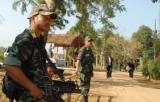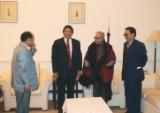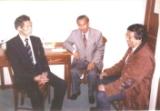Archives
Ceasefire Under Fire
A joint statement released by the United Naga Council (UNC) and the All Naga Students’ Association, Manipur (ANSAM) said the intrusion of 29 AR troops ‘within 20 meters’ of Hebron camp on the 19th of April 2012 is a gross violation of ceasefire ground rules.
It was not comfortable to read the news of this violation of the ceasefire ground rules but the quick admission of this by the Chairman of the Cease Fire Monitoring Group (CFMG), Maj Gen (Retd) N George is appreciated. Let us discuss why we should protect peace.
 When the Government of India declared a ceasefire with the Federal Government of Nagaland (FNG) on September 6th, 1964, there was mixed response. The Naga people were overjoyed because that was the first ever ceasefire declared between the Government of India and FGN. This ceasefire was a hard earned one and prominent Indian political leaders, Naga leaders and even foreigners were deeply involved in the making of this historic and unique ceasefire.
When the Government of India declared a ceasefire with the Federal Government of Nagaland (FNG) on September 6th, 1964, there was mixed response. The Naga people were overjoyed because that was the first ever ceasefire declared between the Government of India and FGN. This ceasefire was a hard earned one and prominent Indian political leaders, Naga leaders and even foreigners were deeply involved in the making of this historic and unique ceasefire.
It may be mentioned that the Nagaland Baptist Church Council (NBCC) was key in effecting this unique ceasefire between the Government of India and the FGN. They had set up the Nagaland Peace Mission with renowned persons like Jayaprakash Narayan, a Sarvodaya leader, Reverend Michael Scott, a British citizen and Bimala Prasad Chaliha, the then Chief Minister of Assam as members.
 The church leaders persuaded the Government of India to halt their military operations for eight days in four villages. During this period, the church leaders along with Rev. Michael Scott visited FGN leaders and discussed the importance of having a ceasefire with the Government of India so as to start political talks to find a solution to their issue. The FGN leaders verbally conveyed their willingness to enter into a ceasefire with the Government of India. That was how things were shaped to reach a logical conclusion for striking an official ceasefire between the Government of India and the FGN.
The church leaders persuaded the Government of India to halt their military operations for eight days in four villages. During this period, the church leaders along with Rev. Michael Scott visited FGN leaders and discussed the importance of having a ceasefire with the Government of India so as to start political talks to find a solution to their issue. The FGN leaders verbally conveyed their willingness to enter into a ceasefire with the Government of India. That was how things were shaped to reach a logical conclusion for striking an official ceasefire between the Government of India and the FGN.
Following the ceasefire between the Government of India and the FGN on September 6th, 1964, political talks started within a few months. The primary objective of this historic ceasefire was to create an atmosphere to find an honorable solution to the Indo-Naga political issue. Talks were held at various places in Nagaland like Chedema, Khensa, etc. And finally it was elevated to the Prime Ministerial level. Prime Minister Indira Gandhi and Naga delegates led by Ato Kilonser (Prime Minister), Gughato Sukhai held talks at New Delhi.
In the 6th round of talks in October, 1967 between Mrs. Gandhi and Sukhai, the talks broke down. Later, the Government of India had unilaterally abrogated the ceasefire in August, 1972. In spite of the breaking down of the historic ceasefire, the FGN still observes this “historic Indo-Naga ceasefire” annually on September 6th.
| It has been fifteen years that the NSCN (IM) and the Government of India have been maintaining their truce and there have been over 60 rounds of talks during this one and a half decades. |
It was very interesting to see how the 8-year old ceasefire and the subsequent talks could not go beyond the sixth round. The most interesting part was why the Government of India, after a few months of granting Nagaland statehood, had to declare an official ceasefire with the Naga underground group? After few months of the declaration of the historic full-fledged “Nagaland Statehood” on the basis of a memorandum submitted by the then Naga People’s Convention (NPC), Delhi declared a ceasefire with the FGN.
On one side, India had to see to the nascent state’s wellbeing and security, on the other they had to deal with the Naga underground leaders to see that their first ever ceasefire was maintained and talks followed. After eight years, the Nagaland state survived, while the talks with the FGN broke down. Violence reared its ugly head again leading to the signing of the infamous Shillong Accord of 1975. The Accord, unfortunately, became the bone of contention among the leaders of the NNC. Some influential leaders broke away from the NNC and formed the NSCN in 1980. Again this split into two factions in 1988 - one headed by Isak Chishi Swu and Th Muivah and the other by SS Khaplang and Dally Mongro.
 It took 33 years for another ceasefire with the Government of India to materialise. It was on July 25th, 1997, that the Prime Minister IK Gujaral announced in the Parliament that the Government of India had entered into a ceasefire with the NSCN (IM). At home, we were all taken aback when the Prime Minister announced the ceasefire with the NSCN (IM). The ceasefire declaration copy signed by NSCN (IM) Chairman Isak Chishi Swu was received by only one paper in Nagaland namely “The Daily Review, Kohima” edited by Mhiesizokho Zinyu. We the members of the media community did not know what to do and were wondering whether the ceasefire document was factually correct. We along with the Zinyu rushed to the Chief Minister’s official residence to meet him and confirm whether the ceasefire had really been entered into. SC Jamir confirmed it and also simultaneously declared from his side about the suspension of operations against the cadre of the NSCN (IM) with immediate effect.
It took 33 years for another ceasefire with the Government of India to materialise. It was on July 25th, 1997, that the Prime Minister IK Gujaral announced in the Parliament that the Government of India had entered into a ceasefire with the NSCN (IM). At home, we were all taken aback when the Prime Minister announced the ceasefire with the NSCN (IM). The ceasefire declaration copy signed by NSCN (IM) Chairman Isak Chishi Swu was received by only one paper in Nagaland namely “The Daily Review, Kohima” edited by Mhiesizokho Zinyu. We the members of the media community did not know what to do and were wondering whether the ceasefire document was factually correct. We along with the Zinyu rushed to the Chief Minister’s official residence to meet him and confirm whether the ceasefire had really been entered into. SC Jamir confirmed it and also simultaneously declared from his side about the suspension of operations against the cadre of the NSCN (IM) with immediate effect.
The NSCN (IM) was arguably the most powerful insurgent group when the Government of India struck a ceasefire with them. Yet to come to a complete cessation of clashes between the security forces and the NSCN (IM) cadres, it took time and a lot of mechanisms and diplomacies were needed because, naturally, it would be quite difficult for the people, who spent most of their lives in jungles, to suddenly come out in public.
One thing we all should understand is that the ceasefire with the Government of India simply didn’t happen. In order to reach such a stage, many stakeholders played their parts. You need to build a bridge of understanding through various channels. Who believed that Isak Chishi Swu and Th Muivah would be coming to Nagaland one day and have free interactions with their people? But it happened. Successive Prime Ministers like Rajiv Gandhi, PV Narasimha Rao, Atal Bihari Vajpayee and their close confidants had immensely contributed their share for matters to reach this stage.
| It took 33 years for another ceasefire with the Government of India to materialise. It was on July 25th, 1997, that the Prime Minister IK Gujaral announced in the Parliament that the Government of India had entered into a ceasefire with the NSCN (IM). |
It has been fifteen years that the NSCN (IM) and the Government of India have been maintaining their truce and there have been over 60 rounds of talks during this one and a half decades. Also the Government of India declared a ceasefire with the NSCN (K) in 2001. (Which has split into two factions – one the GPRN/NSCN, headed by Khole and Kitovi Zhimomi and the other - NSCN (K) which is still headed by S S Khaplang). But even after this development, the Center declared that they continued to maintain ceasefires with both of them.
Everyone is restless and frantically thinking that a solution to the longstanding Indo-Naga political issue will come anytime, maybe in less than a year.
After 65 years of struggle, we need to show now an exemplary maturity to the world that we can still go the extra mile to find a solution and that size is not a matter. The world is fast changing and actually the military concept may not be that relevant for a country’s health after some years. Rather it is going to be a technological fight.
There are mutually agreed upon ceasefire ground rules and, of course, we have seen charges and counter charges of violations of the ground rules by the cadre of the NSCN (IM) and also by the jawans of the Assam Rifles. Such issues are normally discussed during the meetings of the Cease Fire Monitoring Group and they managed to thrash out differences, if any, during such meetings. The present issue should also be tackled in a similar fashion. At the same time, provocative statements should be avoided as far as possible and both parties should exercise maximum restraint for the larger interest of peace in the region. Civil societies should rather, instead of issuing provocative statements, try to step in and educate the party in the wrong not to repeat such actions because we should not allow any party to destroy the peace which has come about at a very high price.
Let us not ‘fire the ceasefire’, without which, talks can not be held. And if talks are not there, then peace will never come. People should keep in mind that in constructing this costly peace, thousands of people have already lost their valuable lives.

